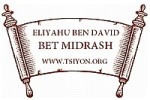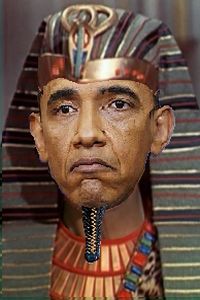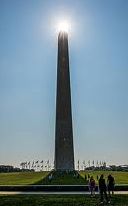TSIYON NEWS
Tsiyon is presently offering Tsiyon Kingdom Silver Shekels at a new reduced rate as a fund-raiser for our ongoing building project. This is a great opportunity to stock up for the days ahead. Download your order form at the bottom of this page.
http://www.assistnews.net/Stories/2010/s10010053.htm
"There is even a reference dating to ca. 1250 BC in Papyrus Anastasi I to a group of giant Shasu living in Canaan who may be identified with the giants encount-ered by the Israelites at the time of the Exodus. Clearly the Egyptians knew about Yahweh as can be seen in the Soleb and Amarah-West topographical lists, but they did not worship him, and they apparently did not want to worship him."
(St. Paul,
Mn.)�The following are excerpts from an
intriguing article published inASSIST News. To
read it in its entirety, click on the link
provided.
 The
oldest historical mention of ancient Israel
occurs in the Merneptah stele, an Egyptian
monument dated to 1208 BC But mention of
Israel's God, Yahweh, occurs even earlier in
Egyptian inscriptions in conjunction with a
group of people called the Shasu. (Photo:
the Merneptah stele)
The
oldest historical mention of ancient Israel
occurs in the Merneptah stele, an Egyptian
monument dated to 1208 BC But mention of
Israel's God, Yahweh, occurs even earlier in
Egyptian inscriptions in conjunction with a
group of people called the Shasu. (Photo:
the Merneptah stele)
Among ancient Egyptian
designations for types of foreign peoples in the
New Kingdom Period (1550�1070 BC), the term
Shasu occurs fairly frequently. It is generally
accepted that the term Shasu means nomads or
Bedouin people, referring primarily to the
nomadic peoples of Syria-Palestine. There are
two hieroglyphic references in New Kingdom
Period texts to an area called "the land of the
Shasu of Yahweh." Except for the Old Testament,
these are the oldest references found in any
ancient texts to the God Yahweh.It is very
likely that the Egyptians of the New Kingdom
Period classified all of the ancient Edomites,
Ammonites, Moabites, Amalekites, Midianites,
Kenites, Hapiru, and Israelites as Shasu.
There is even a reference dating to ca. 1250 BC
in Papyrus Anastasi I to a group of giant Shasu
living in Canaan who may be identified with the
giants encountered by the Israelites at the time
of the Exodus. Clearly the Egyptians knew about
Yahweh as can be seen in the Soleb and Amarah-West
topographical lists, but they did not worship
him, and they apparently did not want to worship
him.
Nor was Yahweh equated to or identified with any
Egyptian deity. There were no temples to Yahweh
built by the Egyptians, nor were there any
artistic representations made of him, or in fact
even any discussions of him in Egyptian texts.
It appears that the ancient Egyptians placed
Yahweh into a category all by himself. To say
the least, this is very strange for the
syncretistic Egyptians. A possible explanation
is that Yahweh was seen by the Egyptians as an
enemy God, of an enemy tribal group which was a
part of the hated Shasu peoples who lived north
of Egypt.
Pharaoh Amenhotep III, or his
scribes, knew about the Hebrew God Yahweh in
1400 BC. This fact is highly significant when
trying to date the exodus of the Israelites from
Egypt under Moses.
In conclusion, It
is clear that there once was a group of Shasu
Bedouin/nomads living in Syria-Palestine who
were associated with either a deity or a place
named Yahweh. It is also clear that the name
Yahweh was known to the Egyptians in the 18th
Dynasty during the reign of Pharaoh Amenhotep
III.
We also know from the Old Testament that there
were other worshippers of Yahweh in Canaan who
did not go into Egypt and therefore did not
leave Egypt at the time of the Exodus. The
question thus arises, were they perhaps the
Shasu of Yahweh mentioned at Soleb and Amarah?
Although we do not have all the information that
we wish we did, it is significant that there are
no mentions of the Shasu of Yahweh in Egyptian
texts earlier than the reign of Amenhotep III...
The reason may very well be because the Shasu of
Yahweh were indeed the Israelites and that they
were still living in Egypt in the early 18th
Dynasty.
The fact that the Shasu of Yahweh first appear
in topographical lists under Amenhotep III in
ca. 1400 BC fits perfectly with the Early Date
of the Exodus, but this fact presents major
problems for those scholars who prefer a Late
Date for the Exodus during the reign of Pharaoh
Ramses II in the 13th century BC. In any case,
these references to Yahweh have been ignored for
far too long by both conservative and liberal
Bible scholars.
It thus appears very likely that the Shasu of
Yahweh, who are mentioned in the topographical
texts at Soleb and Amarah-West, were the
Israelites who by about 1400 BC had settled into
their own land in the mountains of Canaan. It
also appears that for the ancient Egyptians the
one feature that distinguished the Israelites
from all the other Shasu (Semitic herders) in
this area was their worship of the God Yahweh.











 A
number of authors have documented what appears to be a strange
fixation of NASA with the gods of ancient Egyptian religion, the
Osiris Rex ("King Osiris") mission being a current example. This
is but one of many ways that ancient Egypt continues to cast its
long shadow into our modern world. Actually, the mysteries of
ancient Egypt have been considered fascinating by many, from the
time of the ancient Greeks and Romans forward. In fact, the
Greeks and Romans were so enamored with ancient Egypt that they
perpetuated much of the knowledge, culture and even religion of
ancient Egypt by incorporating and adapting it within their own
respective spheres of influence. An interesting example is the
Egyptian phalic symbol known as an obelisk, a massive upright
stone pole tipped with a pyramid shape. Wikipedia
explains:
A
number of authors have documented what appears to be a strange
fixation of NASA with the gods of ancient Egyptian religion, the
Osiris Rex ("King Osiris") mission being a current example. This
is but one of many ways that ancient Egypt continues to cast its
long shadow into our modern world. Actually, the mysteries of
ancient Egypt have been considered fascinating by many, from the
time of the ancient Greeks and Romans forward. In fact, the
Greeks and Romans were so enamored with ancient Egypt that they
perpetuated much of the knowledge, culture and even religion of
ancient Egypt by incorporating and adapting it within their own
respective spheres of influence. An interesting example is the
Egyptian phalic symbol known as an obelisk, a massive upright
stone pole tipped with a pyramid shape. Wikipedia
explains: The
Ancient Romans were strongly influenced by the obelisk form, to
the extent that there are now more than twice as many obelisks
standing in Rome as remain in Egypt .. The largest obelisk
successfully erected in ancient times weighed 455 tons .. All
fell after the Roman period except for the Vatican obelisk and
were re-erected in different locations ..
The
Ancient Romans were strongly influenced by the obelisk form, to
the extent that there are now more than twice as many obelisks
standing in Rome as remain in Egypt .. The largest obelisk
successfully erected in ancient times weighed 455 tons .. All
fell after the Roman period except for the Vatican obelisk and
were re-erected in different locations ..
 Obelisks
are just one example of Ancient Egyptian influence that
continues down to our day. The same pagan Egyptian religion that
inspired the creation of obelisks influences our world in ways
you might never have guessed. It is this same religious
philosophy that was totally repudiated by YHWH through the Ten
Plagues He brought on Egypt, leading up to the Exodus. The
mystery religion of ancient Egypt, remarkably, remains a
formidable competitor, even today, with the true worship of the
one and only True God, Creator of Heaven and Earth, YHWH. The
old pagan religion of Egypt is being covertly revived in our
day. Incredibly, initiation into the Egyptian cult religion goes
on around us on a massive scale, influencing millions, possibly,
even ourselves. Don't think so? Listen to our latest Midrash for
concrete examples, and open your eyes.
Obelisks
are just one example of Ancient Egyptian influence that
continues down to our day. The same pagan Egyptian religion that
inspired the creation of obelisks influences our world in ways
you might never have guessed. It is this same religious
philosophy that was totally repudiated by YHWH through the Ten
Plagues He brought on Egypt, leading up to the Exodus. The
mystery religion of ancient Egypt, remarkably, remains a
formidable competitor, even today, with the true worship of the
one and only True God, Creator of Heaven and Earth, YHWH. The
old pagan religion of Egypt is being covertly revived in our
day. Incredibly, initiation into the Egyptian cult religion goes
on around us on a massive scale, influencing millions, possibly,
even ourselves. Don't think so? Listen to our latest Midrash for
concrete examples, and open your eyes.